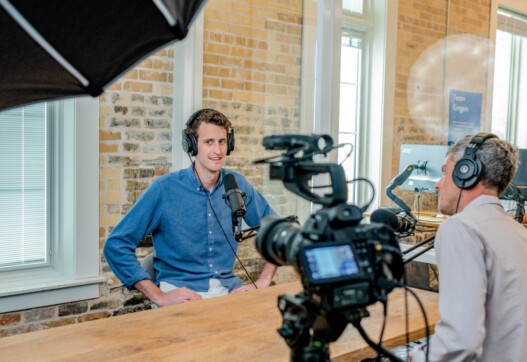The Power of Podcasting: Making Audio Content for Nonprofits

Your nonprofit relies on storytelling to forge emotional connections with potential supporters and spread awareness of your mission. As technology evolves, your nonprofit should expand to tell your story in more engaging, shareable, and innovative ways, such as podcasting.
With nearly half a billion podcast listeners worldwide today, the format is very promising for nonprofit professionals who have detailed stories to tell. However, effectively launching and establishing a nonprofit podcast requires more than a microphone and a social media account. Before you get started, it’s important to grasp the basics of podcasting for nonprofits, including:
- Understanding why podcasts work for nonprofits
- Identifying your podcast’s purpose and audience
- Crafting your podcast’s content
Let’s dive into these podcasting essentials so you can add them to your nonprofit marketing plan.
Understanding Why Podcasting Works for Nonprofits
Aside from gaining access to the millions of podcast fans, employing them as part of your content strategy allows you to:
- Enhance engagement. The conversational nature of podcasts makes them a digestible way for supporters to learn about your nonprofit. Plus, audience members can flexibly choose when to listen to your podcast, whether that’s during their daily commute or just before bed.
- Produce content for a low cost. Besides equipment expenses, podcasting can be very cost-effective if you leverage the right resources. For instance, there are many free resources online, including audio editing software, that dramatically cut podcasting costs.
- Cover a variety of topics. The episodic format of podcasts allows you to cover a variety of topics, whether that’s going in-depth on a topic over multiple installments or covering a few topics in each episode. This allows you to tailor your content calendar to your audience’s or guest’s preferences.
- Connect with nonprofit professionals. Sourcing guest speakers and collaborators for your podcast provides an opportunity to strengthen your relationships with other nonprofit professionals in your community, even if they don’t end up becoming a guest speaker. Plus, inviting thought leaders, influencers, and other guest speakers that your audience cares about helps secure your place as a trustworthy nonprofit.
Now that you understand how podcasts benefit your brand and your budget, let’s get into how to establish your podcast’s identity.
Identifying Your Podcast’s Purpose and Audience
While you might discuss different topics or stories in each episode, the overall purpose and tone of your podcast should remain consistent. Establish the fundamental aspects of your podcast by answering the following questions:
- What is the primary goal of the podcast? Determine whether your podcast will aim to market your mission, educate your audience, achieve a different objective, or fulfill multiple goals.
- What unique perspectives can we offer? The “wow factor” of your podcast is what will draw listeners in. Consider what will set your podcast apart from other nonprofit podcasts.
- Who is our target audience and why would they listen? This answer can help you establish your approach to podcast content. For example, established donors might like to hear about how your fundraising initiatives are going, whereas people who are encountering your nonprofit for the first time might be more interested in your backstory.
- What’s the ideal scope of our podcast? As a beginner podcaster, you should establish the ideal time needed to plan, record, edit, and upload your episodes ahead of time so you can efficiently allocate your resources.
After you’ve answered these questions, you can determine the funnel position for your podcast. This is a way of visualizing the specificity of a marketing message in relation to the desired next action for the audience. You can visualize the marketing funnel with Fifty & Fifty’s diagram that outlines the awareness, consideration, and conversation phases.
For example, a podcast episode spreading general awareness of your nonprofit’s cause would fall into the awareness phase, whereas an episode promoting your upcoming fundraising event would fall in the conversion phase.
Crafting Your Podcast’s Content
Now that you know the general shape of your podcast, start adding depth to your content calendar. No matter which subjects you’re covering, your podcast content should be:
- On-brand. Ensure you always adhere to your brand guidelines, whether you’re crafting your podcast’s slogan or simply determining what your tone will be. For example, a medical nonprofit podcast might be more formal than an animal nonprofit.
- Valuable. Secure a loyal listener base by covering subjects your audience deems worthwhile. You can determine these topics by asking your audience for suggestions or checking your analytics to see which types of topics perform better.
- Diverse. Cover a variety of topics so your audience always has a reason to tune in for the next installment. For example, if you’re part of an environmental-focused nonprofit, you could discuss environmental challenges in one episode and go over popular ways to reuse items in the next.
- Interactive. Your podcast should feel like a two-way conversation, even with listeners who aren’t present in the studio. Depending on your setup, you could accept call-ins, operate a live chat, or ask viewers to send in questions before the episode.
- Consistent. Once you get into the groove of uploading and determine the length of your episodes, try to stick to it as much as possible. This practice will guarantee that you always have content to post.
- Mission-driven. All of your podcast endeavors should tie back to and further your mission in some way, either through spreading awareness of your cause or supporting your fundraising efforts.
When done correctly, your podcast can act as marketing collateral and as a valuable piece of thought leadership. By keeping your goals in mind and ensuring that your content is useful for your listeners, you can create a real impact with your podcast.
Next Steps: Measuring your Podcast’s Success
Gauging how your podcast is performing helps you determine its value to your nonprofit in the long term. Ensure you regularly track metrics such as reviews, listener numbers, audience growth rate, and the conversion rate from listeners to donors. You can monitor these metrics in native data analytics hubs on podcasting platforms such as Spotify, Apple Music, SoundCloud, and Stitcher. Also, remember to collect qualitative data by surveying your listeners about the podcast’s quality and suggestions for improvement.
As your nonprofit evolves, use these metrics paired with your vision for your organization’s future to continue adding depth to your podcast episodes. Keep your mission in mind along with these tips and you can scale your podcast and set yourself up for long-term growth.



